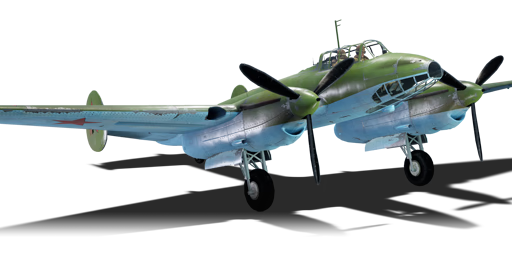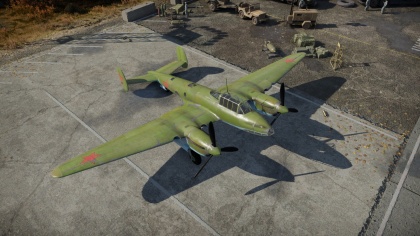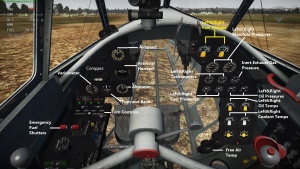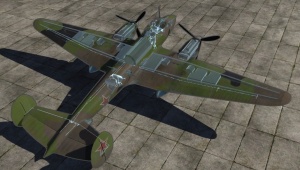Difference between revisions of "Pe-2-1"
(Added tables and basic info.) |
(Updated information.) |
||
| Line 36: | Line 36: | ||
! RB | ! RB | ||
|- | |- | ||
| − | | | + | | 517 || 506 || 8,800 || 29.9 || 28.9 || 7.2 || 7.2 || 326 |
|- | |- | ||
! colspan="8" | ''Upgraded'' | ! colspan="8" | ''Upgraded'' | ||
| Line 201: | Line 201: | ||
| I | | I | ||
| Fuselage Repair | | Fuselage Repair | ||
| + | | Radiator | ||
| | | | ||
| − | | | + | | Offensive 7 mm |
| | | | ||
|- | |- | ||
| II | | II | ||
| | | | ||
| − | | | + | | Compressor |
| − | | | + | | Airframe |
| − | | | + | | New 7 mm MGs |
| + | | DZ-40 | ||
|- | |- | ||
| III | | III | ||
| + | | Wings Repair | ||
| + | | Engine | ||
| | | | ||
| − | | | + | | Turret 7 mm |
| − | |||
| | | | ||
|- | |- | ||
| IV | | IV | ||
| | | | ||
| − | | | + | | Engine Injection |
| − | | | + | | Cover |
| + | | New 7 mm MGs (turret) | ||
| | | | ||
|- | |- | ||
Revision as of 04:58, 21 November 2018
Contents
Description
The Pe-2-1 Peshka is a Rank II Soviet dive bomber with a battle rating of 3.3 (AB/SB) and 3.7 (RB). It was in the game since the start of the Open Beta Test prior to Update 1.29.
The Pe-2 fulfills much the same attack craft role as the IL-2. While the guns are mostly .50 cals and therefore worse than the IL-2's, it can carry much heavier bombs, allowing it to destroy targets in one hit that an IL-2 might take two or three bombs to destroy. Additionally, its nose mounted weaponry and fact that it spawns at bomber altitude in most maps make it a surprisingly effective hit&run bomber. However, as in other attack craft you should have a friendly cover you whenever possible. While it has defensive guns and is faster than the Sturmovik, it is still very vulnerable when caught alone. Additionally, it is very vulnerable to diving attacks due to its dorsal-mounted fuel tank.
However, there are disadvantages as well. The fixed armament is inadequate at best. Two nose-mounted machine guns simply lack the punch of cannons and their low ammunition supply prevents prolonged usage. The defensive armament is not any better – the upper and lower hemisphere of the aircraft are each defended only by a single 7.62 mm machine gun, with the ventral turret having an extremely limited field of view and the side mounts being largely redundant. Your best defense is then the Pe-2’s agility and speed. When attacked by enemy fighters, use your speed to run away and your agility to dodge gun passes, until you have reached friendly fighters or strong allied AAA.
Fast, agile and very versatile, the Peshka can be a great bomber if used correctly and its niche lays in tank battles, as precise dive bomber. Further research of this line will then lead you to even faster and better armed variants. Notably 128 mm rockets, excellent for tank attacks and the occasionally bomber.
General info
Flight Performance
| Characteristics | |||||||
|---|---|---|---|---|---|---|---|
| Stock | |||||||
| Max Speed (km/h at 5,100 m) |
Max altitude (meters) |
Turn time (seconds) |
Rate of climb (meters/second) |
Take-off run (meters) | |||
| AB | RB | AB | RB | AB | RB | ||
| 517 | 506 | 8,800 | 29.9 | 28.9 | 7.2 | 7.2 | 326 |
| Upgraded | |||||||
| Max Speed (km/h at 5,100 m) |
Max altitude (meters) | Turn time (seconds) | Rate of climb (meters/second) |
Take-off run (meters) | |||
| AB | RB | AB | RB | AB | RB | ||
| ? | ? | 8,800 | ??.? | ??.? | ?.? | ?.? | 326 |
Details
| Features | ||||
|---|---|---|---|---|
| Combat flap | Take-off flap | Landing flap | Air brakes | Arrestor gear |
| ✓ | ✓ | ✓ | X | X |
| Limits | ||||
|---|---|---|---|---|
| Wing-break speed (km/h) |
Gear limit (km/h) |
Combat flap (km/h) |
Max Static G | |
| + | - | |||
| 760 | 850 | ??? | ~8 | ~4 |
| Optimal velocities | |||
|---|---|---|---|
| Ailerons (km/h) |
Rudder (km/h) |
Elevators (km/h) |
Radiator (km/h) |
| < 380 | < 380 | < 440 | > 250 |
| Compressor (RB/SB) | ||
|---|---|---|
| Setting 1 | ||
| Optimal altitude | 100% Engine power | WEP Engine power |
| 2,000 m | 2,200 hp | 2,372 hp |
| Setting 2 | ||
| Optimal altitude | 100% Engine power | WEP Engine power |
| 4,000 m | 2,100 hp | 2,265 hp |
Survivability and armour
- 8 mm Steel plate behind the pilot
- No armour glazing
- Critical components located at front of aircraft (fuel, pilot, engine, controls)
- More fuel tanks located in wings near fuselage
Armaments
Offensive armament
The Pe-2-1 is armed with:
- 2 x 7.62 mm ShKAS machine guns, nose-mounted (500 rpg = 1,000 total)
Suspended armament
The Pe-2-1 can be outfitted with:
- 6 x 100 kg FAB-100 bombs (600 kg total)
- 4 x 100 kg FAB-100 bombs + 2 x 250 kg FAB-250M43 bombs (900 kg total)
- 4 x 250 kg FAB-250M43 bombs (1,000 kg total)
- 2 x 500 kg FAB-500 bombs (1,000 kg total)
Defensive armament
The Pe-2-1 is defended by:
- 1 x 7.62 mm ShKAS machine gun, dorsal turret (750 rpg)
- 1 x 7.62 mm ShKAS machine gun, ventral turret (750 rpg)
Usage in the battles
The Pe-2-1 Peshka's firepower is rather meager, only really meant to scare off the enemies with the right angle. The 7.62 mm calibre weapons won't be destroying enemy aircraft with a quick burst. The defensive turrets are also armed with the same 7.62 mm weapons which are also poor in both firepower and protection. The turret firing arcs are small (Dorsal: 80° horizontal, +5 – 60° vertical; Ventral: 80° horizontal, -10 – -20° vertical) and open hatches mean that there are blind spots and the gunners could be quickly dispatched by a strafing aircraft.
However, the Pe-2-1 Peshka shines in its versatile and useful payload variant, especially the 2 x 250 kg + 4 x 100 kg option. Those dual outside mounted 250 kg bombs do NOT drop in pairs as usual (RB/SB effect). The same applies to 2 x 500 kg payload. Each one drops single upon pressing the release button. Beware though: The unlockable payload options take a big toll on climb rate, acceleration and speed. For quick and speedy mission, the stock six times 100 kg bombs all mounted inside remains a very good choice.
Manual Engine Control
| MEC elements | ||||||
|---|---|---|---|---|---|---|
| Mixer | Pitch | Radiator | Supercharger | Turbocharger | ||
| Oil | Water | Type | ||||
| Controllable | Not controllable | Not controllable | Not controllable | Separate | Not ontrollable | Not controllable |
Modules
| Tier | Flight performance | Survivability | Weaponry | ||
|---|---|---|---|---|---|
| I | Fuselage Repair | Radiator | Offensive 7 mm | ||
| II | Compressor | Airframe | New 7 mm MGs | DZ-40 | |
| III | Wings Repair | Engine | Turret 7 mm | ||
| IV | Engine Injection | Cover | New 7 mm MGs (turret) | ||
- The first rank of upgrades do not matter much, just choose either two out of three to unlock research for rank II.
- When possible, choose DZ-40 first to unlock more payload variants. Afterwards the only thing to worry about is performance. Acceleration takes a hit with the newer heavier payloads.
Pros and cons
Pros:
- Nose mounted weaponry
- Versatile bomb load for an attack craft
- Rather maneuverable for a twin-engine attack craft
- One of the faster twin engine dive/light bombers
- All metal construction results in sturdy airframe. Can handle up to 800 km/h dives
- Can develop huge speed advantage over competition by trading altitude for speed (this bomber is one of the better rush bombers)
Cons:
- Large target
- 7.62 mm insufficient for any ground target, except trucks
- Large fuel tank in the midsection makes it vulnerable to fires
- Armor does not protect back gunner and pilot is only protected from the back
- Poor field of view of the back gunners. 7.62 mm is not only insufficient for self defense, but often cannot even get a proper aim if attacker is careful
History
Originally, the Petlyakov Pe-2 was not supposed to be a bomber at all. Its direct predecessor, designated VI-100, was designed by a prison design bureau team led by Vladimir Petlyakov as a high-altitude escort fighter. The VI-100 was very modern for its time, featuring a pressurized two-seat cockpit, electrically actuated systems and all-metal construction, and was powered by two supercharged Klimov M-105 V-12 inline engines producing 1100 horsepower each. The prototype was completed in 1939 and during its first test flight on 7th May 1939 it reached a top speed of 627.6 kph (390 mph) – an astounding performance for its time. The results of flight tests were so promising that the VI-100 was ordered into production.
However, Germany launched the “Blitzkrieg“ campaign in September 1939. Aside from their revolutionary usage of tanks, the campaign in Poland featured notable usage of Ju 87 dive bombers and showed their potential. Consequently, the Soviet authorities ordered the VI-100 to be redesigned as a dive bomber. Pressurization equipment and engine superchargers were removed, dive brakes were installed under the wings and the bombardier position was added to the nose of the aircraft(raising the number of crew members to three). A ventral bomb bay was added along with the two smaller bomb positions located at the rear of engine nacelles. Two rear-facing turrets, each armed by a single ShKAS machine gun, were installed to dorsal and ventral positions. Resulting aircraft, able to carry up to 1600 kg / 3520 lbs of bombs, was designated PB-100. The first prototype flew on 15th December 1940 and its performance (top speed of 540.7 kph/336 mph) was so good that Vladimir Petlyakov was released and the aircraft was named after him, thus receiving the designation Petlyakov Pe-2. The bomber was then rushed into serial production and deliveries to combat units began in the spring of 1941. The deliveries were, however, slow and by the time of the German invasion in June 1941, only about 458 Pe-2’s were delivered.
The Pe-2, nicknamed Peshka („Pawn“) by its crews, quickly proved itself to be an effective dive bomber and together with the Ilyushin Il-2 Sturmovik attacker, it became the most important offensive weapon of the Soviet Army Air Force. The bomber was fast and agile enough to be an elusive target for German fighters and also proved its versatility – it was used for reconnaissance and artillery spotting and also became the basis for the Pe-3 heavy fighter. Losses were heavy, however. Crews often complained about a lack of armour protection for the cockpit and fuel tanks as well as poor defensive armament and unreliable dive brakes, which sometimes failed to retract and allowed top speeds of only around 300 kph (186.4 mph), making the fast bomber easy prey.
Ingame description
A twin-engine, all-metal monoplane with a twin-fin tail and a retractable landing gear system with tail wheel.
The idea to create the Pe-2 front line dive bomber was born quite suddenly. The experiences of World War II, which had just recently started, showed that the concept of heavy twin-engine fighters was defective. The planes either failed miserably or had to play a different role in the conflict. The Petlyakov VI-100 high-altitude fighter created in OKB-29 of the NKVD's Special Technical Bureau was no exception. Despite its impressive test results, with characteristics significantly exceeding those of its European counterparts, and despite the fact that industrial facilities were prepared for mass production, it was decided that the aircraft should not begin production, for it was clear that such planes were simply not needed. At the same time, the Air Forces of the Workers’ and Peasants’ Red Army clearly required that the fleet of front line bomber aircraft be upgraded and replenished. Dive bombers in particular had made a good showing in the first years of World War II, but planes of this type were absent in the USSR's forces. It was decided to make up this deficiency by converting the VI-100 fighter. In principle, this design was quite promising, and the industry was ready for mass production. In addition, there was no time to develop a completely new design. As a result, Petlyakov was ordered to prepare in the shortest possible time a PB-100 dive bomber based on the existing fighter prototype.
Only one month and a half were given to perform the redesign, but the designers pulled it off brilliantly. In the autumn of 1940, the PB-100 successfully passed all tests and was immediately launched into full-scale production. In 1940, the aircraft was re-designated the Pe-2, after the last name of designer V. M. Petlyakov. The first series were few in number: usually 5 to 10 planes, and 20 at most. This was done specifically to allow for improvements during production.
The first production planes were equipped with 1,100 hp Klimov M-105R twelve-cylinder V-type geared water-cooled engines.
The plane's defensive armament consisted of four 7.62 mm ShKAS machine guns. Two ShKAS machine guns with 500 rounds each were fixed in the forward fuselage, and the navigator could fire from the TSS-1 turret (with a magazine capacity of 750 rounds) mounted behind the pilot. The LU-MV-2 hatch mount with 750 rounds was located in the lower fuselage.
The standard payload of the Pe-2 was 600 kg, and the maximum was 1,000 kg. Four bombs with a maximum weight of 100 kg were housed in the fuselage bomb bay, and one more bomb was placed in each of the two bomb bays located in the nacelle rear section. Bombs of larger weights, such as 250 kg and 500 kg, could be accommodated only on external bomb racks under the center wing section.
Media
An excellent addition to the article will be video guides, as well as screenshots from the game and photos.
Read also
Sources
Paste links to sources and external resources, such as:
- topic on the official game forum;
- page on aircraft encyclopedia;
- other literature.
| USSR bombers | |
|---|---|
| SB and Ar | SB 2M-100 · SB 2M-103 · SB 2M-103 MV-3 · SB 2M-103U · SB 2M-103U MV-3 · SB 2M-105 · Ar-2 |
| Yer-2 (petrol) | Yer-2 (M-105) · Yer-2 (M-105) TAT · Yer-2 (M-105R) TAT · Yer-2 (M-105R) LU |
| Yer-2 (diesel) | Yer-2 (ACh-30B) (e) · Yer-2 (ACh-30B) (l) |
| Tu | Tu-2 · Tu-2S · Tu-2S-44 · Tu-2S-59 · Tu-4 |
| Pe | Pe-2-1 · Pe-2-31 · Pe-2-83 · Pe-2-110 · Pe-2-205 · Pe-2-359 · Pe-8 |
| IL | DB-3B · IL-4 |
| Po | Po-2 · Po-2M |
| Other | MBR-2-M-34 · TB-3M-17-32 · Yak-4 · Be-6 |
| Lend-Lease | ▂PBY-5A Catalina · ▂Hampden TB Mk I · ▂A-20G-30 · ▂B-25J-30 |







